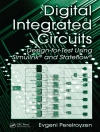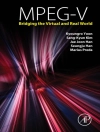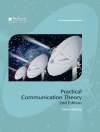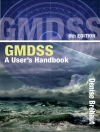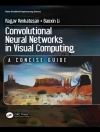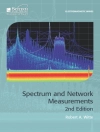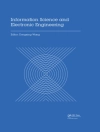The volume contains 75 papers presented at International Conference on Communication and Networks (COMNET 2015) held during February 19–20, 2016 at Ahmedabad Management Association (AMA), Ahmedabad, India and organized by Computer Society of India (CSI), Ahmedabad Chapter, Division IV and Association of Computing Machinery (ACM), Ahmedabad Chapter. The book aims to provide a forum to researchers to propose theory and technology on the networks and services, share their experience in IT and telecommunications industries and to discuss future management solutions for communication systems, networks and services. It comprises of original contributions from researchers describing their original, unpublished, research contribution. The papers are mainly from 4 areas – Security, Management and Control, Protocol and Deployment, and Applications. The topics covered in the book are newly emerging algorithms, communication systems, network standards, services, and applications.
Mục lục
Chapter 1. A Novice Approach for Web Application Security.- Chapter 2. Correlation between Text book usage and Academic Performance of Student in Higher Education Using ‘R’.- Chapter 3. Human Computer Interaction through Hand Gestures for Home Automation Using Microsoft Kinect.- Chapter 4. Enhancement of Security in Io TSy S Framework.- Chapter 5. Segmentation and Recognition of Fingers Using Microsoft Kinect.- Chapter 6. Randomness Evaluation of ZUC, SNOW and GRAIN Stream Ciphers.- Chapter 7. MSECHP: More Stable Election of Cluster Head Protocol for Heterogeneous Wireless Sensor Network.- Chapter 8. Use of ICT for Development of Smart City-Ahmedabad.- Chapter 9. Optimization of the Neighbor Parameter of k-Nearest Neighbor Algorithm for Collaborative Filtering.- Chapter 10. The Efficient Scheme for Contention Reduction in Bufferless OBS Network.- Chapter 11. Empowering Throughput over Proactive Wireless Network Using Multi-streaming.- Chapter 12. Control of Robot Using Neural Networks.- Chapter 13. Achieving Energy Aware Mechanism in Cloud Computing Environment.- Chapter 14. Information Security Emergency Plan Management System.- Chapter 15. Reliability-Aware Workflow Scheduling Using Monte Carlo Failure Estimation in Cloud.- Chapter 16. Realization of Virtual Resource Management Framework in Iaa S Cloud Federation.- Chapter 17. Designing an Enhanced Simulation Module for Multimedia Transmission over Wireless Standards.- Chapter 18. Mitigating Data Segregation and Privacy Issues in Cloud Computing.- Chapter 19. Software Risk Measurement and Interpretation with Generated Precedence Matrix.- Chapter 20. IMSS: A Novel Approach to Design of Adaptive Search System Using Second Generation Big Data Analytics.- Chapter 21. Energy Efficient Cluster Head Selection in Energy-LEACH.- Chapter 22. MMR-LEACH: Multi-tier Multi-hop Routing in LEACH Protocol.- Chapter 23. Cooperative Sensors for Identifying an Impulsive Events of Asynchronous Environment.- Chapter 24. Trust Integrated Federated Architecture Ranking Service Models in Cloud Computing Environment.- Chapter 25. Leakage Power Reduction Technique by Using Multigate Fin FET in DSM Technology.- Chapter 26. Home Automation Using Single Board Computing as an Internet of Things Application.- Chapter 27. Objective Quality Assessments of Restoration Images.- Chapter 28. mi BEAT based Continuous and Robust Biometric Identification System for on-the-go Applications.- Chapter 29. Classification of Technical and Management Metrics in Object Oriented Software Engineering.- Chapter 30. Publish/Subscribe Mechanism for Io T: A Survey of Event Matching Algorithms and Open Research Challenges.- Chapter 31. Chronic Kidney Disease Prediction Using Back Propagation Neural Network Algorithm.- Chapter 32. Internet of Things (Io T) Based Water Level Monitoring System for Smart Village.- Chapter 33. Application of Remote Sensing for Assessing Forest Cover Conditions of Aurangabad, (MS), India.- Chapter 34. Encry Scation: A secure Approach for Data Security Using Encryption and Obfuscation Techniques for Iaa S and Daa S Services in Cloud Environment.- Chapter 35. Prediction of Students Performance of an Institute Using Classification Via Clustering and Classification Via Regression.- Chapter 36. Feature Based Object Mining and Tagging Algorithm for Digital Images.- Chapter 37. Exploratory Assessment Based Child Nodes Selection (EACNS): Energy Efficient Multicast Routing Topology for Mobile Ad Hoc Networks.- Chapter 38. Improved EAACK to Overcome Attacks in MANET and Wireless Sensor Networks.- Chapter 39. An Efficient System Model for Multicasting Measured Noise Value of Polluting Industries.- Chapter 40. Internet of Things based Smart Home with Intel Edison.- Chapter 41. Image Classification Using Discrete Block Truncation Coding.- Chapter 42. Preprocessing of log Files Using Diffusion Map for Forensic Examination.- Chapter 43. An Efficient and Robust Image Steganographic Technique without Stuffing Data bits.- Chapter 44. Security Requirements for Internet of Things (Io T).- Chapter 45. Identity Based Secure RSA Encryption System.- Chapter 46. Using Genetic Algorithm for Process Migration in Multicore Kernels.- Chapter 47. An Extensive Conception of Reusability in Software Component Engineering.- Chapter 48. Opportunistic Location Update – A Novel Cost Efficient Reactive Approach to Remove Pauses in Cellular Networks.- Chapter 49. Fuzzy Analytic Hierarchy Process for Software Durability: Security Risks Perspective.- Chapter 50. Sorted K-Means towards the enhancement of K-Means to Form Stable Clusters.- Chapter 51. Target Tracking Accuracy in Contextof Energy Consumption in Wireless Sensor Network.- Chapter 52. Security in Mobile Ad hoc Networks.- Chapter 53. Design of Ultra Low Power Voltage Controlled Ring Oscillator.- Chapter 54. A Dynamic Session Oriented Clustering Approach for Detecting Intrusions in Databases.- Chapter 55. Cognitive Decision Making for Object Recognition by Humanoid System.- Chapter 56. Comprehensive Trust Based Scheme to Combat Malicious Nodes in MANET Based Cyber Physical Systems.- Chapter 57. A Review on Wireless Mobile Communication Systems Generations and Integration.- Chapter 58. Reducing the Cold-user and Cold-item problem in Recommender System by reducing the Sparsity of the Sparse Matrix and Addressing the Diversity-accuracy Problem.- Chapter 59. Differential Voltage Controlled Ring Oscillators – A Review.- Chapter 60. An Advanced Web-Based Bilingual Domain Independent Interface to Database Using Machine Learning Approach.- Chapter 61. Comparison of ABC Framework with AHP, Wiegers method, Cost-value, Priority Groups for Requirements Prioritization.- Chapter 62. Scalability Analysis of Medium Access Control Protocols for Internet of Things.- Chapter 63. A Review on Comparison of Workflow Scheduling Algorithms with Scientific Workflows.- Chapter 64. Predictive Approach of CBR in Artificial Intelligence: A Case of Astrological Predictions About the status of Person.- Chapter 65. Machine to Machine Sensor Network Implementation for Securing Railway Transport.- Chapter 66. Real Time Street Light System Using Low Power Microcontroller.- Chapter 67. Dealing with Indian Jurisprudence by Analyzing the Web Mining Results of a Case of Cybercrimes.- Chapter 68. New Approach for Performance and Security Enhancement in OCDMA Networks.- Chapter 69. Decision Based Spectral Embedding Approach for Identifying Facial Behavior on RGB-D Images.- Chapter 70. LTTC: A Load Testing Tool for Cloud.- Chapter 71. A Hybrid Approach to Enhance the Security of Automated Teller Machine.- Chapter 72. A Novel Approach for Copy Move Forgery Detection Using Template Matching.- Chapter 73. Analysis of Rule Based Expert Systems developed and implemented for Career Selection.- Chapter 74. A Pragmatic Analysis of Security and Integrity in Software Defined Networks.- Chapter 75. Modern Approach for Vehicle Traffic Monitoring & Signal Management System in ITS.
Giới thiệu về tác giả
Dr. Nilesh Modi is Professor and Head of the Department, Narsinhbhai Institute of Computer Studies and Management, Gujarat, India. He has rich experience of around 13 years in academics and IT industry. Dr. Modi is doctorate in e-Security (Computer Science and Application). Continuing his research on Cyber Security, presently he is pursuing post-doctoral research on Wireless Communication and Security and certification in Ethical Hacking. He is working as a recognized research supervisor for Ph D and M.Phil. programs for different universities in India. He has reviewed number of Ph D, M.Phil. and M.Tech. thesis from different universities in India and abroad. He is also serving as a manuscript reviewer and program committee member for different research journals and conferences of national and international repute in the world. He has published more than 75 research papers in International and National Journals and Conference Proceedings. He has delivered number of experttalk on e-Security and hacking in National and International Conferences.
Dr. Modi is an active life member of CSI, ACM IEEE, IACSIT, IACSI, IAEng apart from his academic and industrial career. As a consultant, he is contributing to different system development projects with IT industry and actively involved in different Government projects. He is also serving as a member of Board Of Studies and Selection Committee in Gujarat Technological University along with different universities in the country. He is working as district coordinator for SANDHAN Program initiated by Government of Gujarat.
Dr. Pramode K Verma joined The University of Oklahoma in Tulsa as Professor of Computer Engineering and Director of the T-Com program in December 1999. Besides teaching and research, his responsibilities include creating cooperative endeavors with the information technology corporations in the Tulsa region. Dr. Verma obtained his doctorate in Electrical Engineering from Concordia University in 1970, a Bachelor’s degree in Engineering in 1962 from the Indian Institute of Science, Bangalore, and a Bachelor’s degree in Science (Honors) in 1959 from Patna University, India. In 1984, he also obtained an M.B.A. from the Wharton School of the University of Pennsylvania. He is the author of over fifty publications in telecommunications, computer communications and related fields. His other professional accomplishments include Editor, Journal of Telecommunication Networks, 1982-1985; and Contributor to the Mc Graw Hill Encyclopedia of Science and Technology (Sixth Edition).Dr. Verma is the author of Performance Estimation of Computer Communication Networks: A Structured Approach, published by the Computer Science Press (1989), and the contributing editor of ISDN Systems: Architecture, Technology, and Applications, published by Prentice-Hall, Inc. (1990). His first book has been translated into French and published as Modeles des Performances des Reseaux in 1992 by W. H. Freeman and Company. He is a contributor to So This is 1984: Some Personal Views by Governors of the International Council for Computer Communication, published by Elsevier Science Publishers B.V. (1984). More recently, Dr. Verma contributed to and co-edited The Computer Communication Revolution Multidisciplinary Retrospective and Prospective, published by the ICCC Press, 1997. He has been a keynote speaker at a number of conferences, including the third annual convention of the Computer Society of India in New Delhi. His research interests include Telecommunications Networks, Networking Technology and Interoperability.
Prof. Bhushan Trivedi joined the GLS University as Professor of Computer Technology in 1999. He is now serving the GLS Institute of Computer Technology as Director. Prof. Trivedi obtained his doctorate from Hemchandracharya North Gujarat University in 2008, MCA degree from MS University, Vadodara in 1988 and BSc from Gujarat University in 1984. He has over 35 papers published in national and international level journals and several contributions in conference proceedings. His interest areas are effective teaching techniques, network security, and sensor networks.


